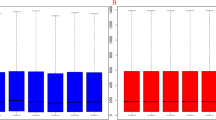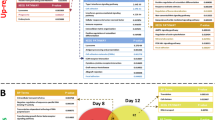Abstract
In order to explore the differential effects of TGF-beta3 and BMP2 on chondrogenesis in mesenchymal stem cells (MSCs), the gene expression profiles of MSC treated with TGF-beta3 and BMP2 were subjected to systematic analysis on the gene and functional level. The gene expression profiles of MSCs (downloaded from Gene Expression Omnibus database) in the early and later stages, induced with TGF-beta2 and BMP2, were analyzed using packages within R software and the differentially expressed genes (DEGs) were screened. The DEGs both in the two experimental groups were subjected to Gene Ontology and pathway enrichment analysis. The protein–protein interaction (PPI) networks of the DEGs were constructed using cytoscape software. Among the DEGs, 1,194 genes were up-regulated and 580 genes were down-regulated. The up-regulated genes were mainly enriched in the TGF-beta and cell cycle signaling pathways and down-regulated genes were mainly enriched in the insulin-mediated signal pathway, metabolic pathway of fructose and mannose, and glycolysis/gluconeogenesis pathway. Based on the PPI network analysis, the genes of KIAA0101, NEDD4, and TINF2 were confirmed to be important on chondrogenesis. The analysis of DEGs both in TGF-beta3 and BMP2 treated MSCs indicates that the genes are mainly involved in the cell cycle and intracellular signaling pathways. Also the similar gene expression profile can be achieved by transcription factors or microRNAs (miR-199a-5p and miR-31-5p) based on our prediction, which can provide a new approach for the treatment of cartilage injury.


Similar content being viewed by others
References
Curl WW, Krome J, Gordon ES, Rushing J, Smith BP, Poehling GG (1997) Cartilage injuries: a review of 31,516 knee arthroscopies. Arthroscopy 13(4):456–460
Buckwalter J, Mankin H (1997) Articular cartilage. Part II: degeneration and osteoarthrosis, repair, regeneration, and transplantation. J Bone Joint Surg Am 79(4):612–632
Guilak F, Fermor B, Keefe FJ, Kraus VB, Olson SA, Pisetsky DS, Setton LA, Weinberg JB (2004) The role of biomechanics and inflammation in cartilage injury and repair. Clin Orthop Relat Res 423:17–26
Francis Suh J-K, Matthew HW (2000) Application of chitosan-based polysaccharide biomaterials in cartilage tissue engineering: a review. Biomaterials 21(24):2589–2598
O’Driscoll SW (1998) Current concepts review-the healing and regeneration of articular cartilage*. J Bone Joint Surg 80(12):1795–1812
Temenoff JS, Mikos AG (2000) Review: tissue engineering for regeneration of articular cartilage. Biomaterials 21(5):431–440
Shapiro F, Koide S, Glimcher M (1993) Cell origin and differentiation in the repair of full-thickness defects of articular cartilage. J Bone Joint Surg Am 75(4):532
Lee JW, Kim YH, Kim SH, Han SH, Hahn SB (2004) Chondrogenic differentiation of mesenchymal stem cells and its clinical applications. Yonsei Med J 45(Suppl):S41–S47
Li W-J, Tuli R, Okafor C, Derfoul A, Danielson KG, Hall DJ, Tuan RS (2005) A three-dimensional nanofibrous scaffold for cartilage tissue engineering using human mesenchymal stem cells. Biomaterials 26(6):599–609
Grimaud E, Heymann D, Rédini F (2002) Recent advances in TGF-β effects on chondrocyte metabolism: potential therapeutic roles of TGF-β in cartilage disorders. Cytokine Growth Factor Rev 13(3):241–257
Majumdar MK, Wang E, Morris EA (2001) BMP-2 and BMP-9 promotes chondrogenic differentiation of human multipotential mesenchymal cells and overcomes the inhibitory effect of IL-1. J Cell Physiol 189(3):275–284
Irizarry RA, Hobbs B, Collin F, Beazer-Barclay YD, Antonellis KJ, Scherf U, Speed TP (2003) Exploration, normalization, and summaries of high density oligonucleotide array probe level data. Biostatistics 4(2):249–264
Dai M, Wang P, Boyd AD, Kostov G, Athey B, Jones EG, Bunney WE, Myers RM, Speed TP, Akil H (2005) Evolving gene/transcript definitions significantly alter the interpretation of GeneChip data. Nucleic Acids Res 33(20):e175
Storey JD, Tibshirani R (2003) Statistical significance for genomewide studies. Proc Natl Acad Sci USA 100(16):9440–9445
Da Wei Huang BTS, Lempicki RA (2008) Systematic and integrative analysis of large gene lists using DAVID bioinformatics resources. Nat Protoc 4(1):44–57
Parikh JR, Xia Y, Marto JA (2012) Multi-edge gene set networks reveal novel insights into global relationships between biological themes. PLoS One 7(9):e45211
Chatr-aryamontri A, Breitkreutz B-J, Heinicke S, Boucher L, Winter A, Stark C, Nixon J, Ramage L, Kolas N, O’Donnell L (2013) The BioGRID interaction database: 2013 update. Nucleic Acids Res 41(D1):D816–D823
Enright AJ, Van Dongen S, Ouzounis CA (2002) An efficient algorithm for large-scale detection of protein families. Nucleic Acids Res 30(7):1575–1584
Shannon P, Markiel A, Ozier O, Baliga NS, Wang JT, Ramage D, Amin N, Schwikowski B, Ideker T (2003) Cytoscape: a software environment for integrated models of biomolecular interaction networks. Genome Res 13(11):2498–2504
Maere S, Heymans K, Kuiper M (2005) BiNGO: a cytoscape plugin to assess overrepresentation of gene ontology categories in biological networks. Bioinformatics 21(16):3448–3449
Lamb J, Crawford ED, Peck D, Modell JW, Blat IC, Wrobel MJ, Lerner J, Brunet J-P, Subramanian A, Ross KN (2006) The connectivity map: using gene-expression signatures to connect small molecules, genes, and disease. Sci Signal 313(5795):1929
Hsu S-D, Lin F-M, Wu W-Y, Liang C, Huang W-C, Chan W-L, Tsai W-T, Chen G-Z, Lee C-J, Chiu C-M (2011) miRTarBase: a database curates experimentally validated microRNA-target interactions. Nucleic Acids Res 39(suppl 1):D163–D169
Chang JT, Nevins JR (2006) GATHER: a systems approach to interpreting genomic signatures. Bioinformatics 22(23):2926–2933
Furusawa S, Nakano S, Wu J, Sakaguchi S, Takayanagi M, Sasaki KI, Satoh S (2001) Apoptosis induced by doxorubicin and cinchonine in P388 multidrug-resistant cells. J Pharm Pharmacol 53(7):1029–1039
Hu F, Gartenhaus RB, Zhao XF, Fang H-B, Minkove S, Poss DE, Rapoport AP (2012) c-Myc and E2F1 drive PBK/TOPK expression in high-grade malignant lymphomas. Leuk Res 37(4):447–454
Scheijen B, Bronk M, van der Meer T, Bernards R (2003) Constitutive E2F1 overexpression delays endochondral bone formation by inhibiting chondrocyte differentiation. Mol Cell Biol 23(10):3656–3668
Jain M, Zhang L, Patterson EE, Kebebew E (2011) KIAA0101 is overexpressed, and promotes growth and invasion in adrenal cancer. PLoS One 6(11):e26866
Hosokawa M, Takehara A, Matsuda K, Eguchi H, Ohigashi H, Ishikawa O, Shinomura Y, Imai K, Nakamura Y, Nakagawa H (2007) Oncogenic role of KIAA0101 interacting with proliferating cell nuclear antigen in pancreatic cancer. Cancer Res 67(6):2568–2576
Shahdadfar A, Frønsdal K, Haug T, Reinholt FP, Brinchmann JE (2005) In vitro expansion of human mesenchymal stem cells: choice of serum is a determinant of cell proliferation, differentiation, gene expression, and transcriptome stability. Stem cells 23(9):1357–1366
Liu L, Chen X, Xie S, Zhang C, Qiu Z, Zhu F (2012) Variant 1 of KIAA0101, overexpressed in hepatocellular carcinoma, prevents doxorubicin-induced apoptosis by inhibiting p53 activation. Hepatology 56(5):1760–1769
Fan C-D, Lum MA, Xu C, Black JD, Wang X (2013) Ubiquitin-dependent regulation of phospho-AKT dynamics by the ubiquitin E3 ligase, NEDD4-1, in the insulin-like growth factor-1 response. J Biol Chem 288(3):1674–1684
Milkereit R, Rotin D (2011) A role for the ubiquitin ligase Nedd4 in membrane sorting of LAPTM4 proteins. PLoS One 6(11):e27478
Nethe M, de Kreuk B-J, Tauriello DV, Anthony EC, Snoek B, Stumpel T, Salinas PC, Maurice MM, Geerts D, Deelder AM (2012) Rac1 acts in conjunction with Nedd4 and dishevelled-1 to promote maturation of cell–cell contacts. J Cell Sci 125(14):3430–3442
Xin Z-T, Carroll KA, Kumar N, Song K, Ly H (2011) Transcriptional activation of TINF2, a gene encoding the telomere-associated protein TIN2, by Sp1 and NF-κB factors. PLoS One 6(6):e21333
Yamada M, Tsuji N, Nakamura M, Moriai R, Kobayashi D, Yagihashi A, Watanabe N (2002) Down-regulation of TRF1, TRF2 and TIN2 genes is important to maintain telomeric DNA for gastric cancers. Anticancer Res 22(6A):3303
Landgraf P, Rusu M, Sheridan R, Sewer A, Iovino N, Aravin A, Pfeffer S, Rice A, Kamphorst AO, Landthaler M (2007) A mammalian microRNA expression atlas based on small RNA library sequencing. Cell 129(7):1401–1414
Lin EA, Kong L, Bai X-H, Luan Y, Liu C-j (2009) miR-199a*, a bone morphogenic protein 2-responsive microRNA, regulates chondrogenesis via direct targeting to Smad1. J Biol Chem 284(17):11326–11335
Betel D, Wilson M, Gabow A, Marks DS, Sander C (2008) The microRNA.org resource: targets and expression. Nucleic Acids Res 36(suppl 1):D149–D153
Gao J, Yang T, Han J, Yan K, Qiu X, Zhou Y, Fan Q, Ma B (2011) MicroRNA expression during osteogenic differentiation of human multipotent mesenchymal stromal cells from bone marrow. J Cell Biochem 112(7):1844–1856
Malladi P, Xu Y, Chiou M, Giaccia AJ, Longaker MT (2007) Hypoxia inducible factor-1α deficiency affects chondrogenesis of adipose-derived adult stromal cells. Tissue Eng 13(6):1159–1171
Acknowledgments
This project was sponsored by the National Science & Technology Major Project of China (Key Innovative Drug Development), No.2011ZX09202-301-14 and Shanghai JiaoTong University Innovation Fund for “Cross Research of Medicine and Engineering(Science)”, No.YG2012MS45, was also greatly appreciated.
Conflict of interest
The authors declare that there are no any conflicts of interest.
Author information
Authors and Affiliations
Corresponding author
Rights and permissions
About this article
Cite this article
Sang, Y., Zang, W., Yan, Y. et al. Study of differential effects of TGF-beta3/BMP2 on chondrogenesis in MSC cells by gene microarray data analysis. Mol Cell Biochem 385, 191–198 (2014). https://doi.org/10.1007/s11010-013-1827-z
Received:
Accepted:
Published:
Issue Date:
DOI: https://doi.org/10.1007/s11010-013-1827-z




